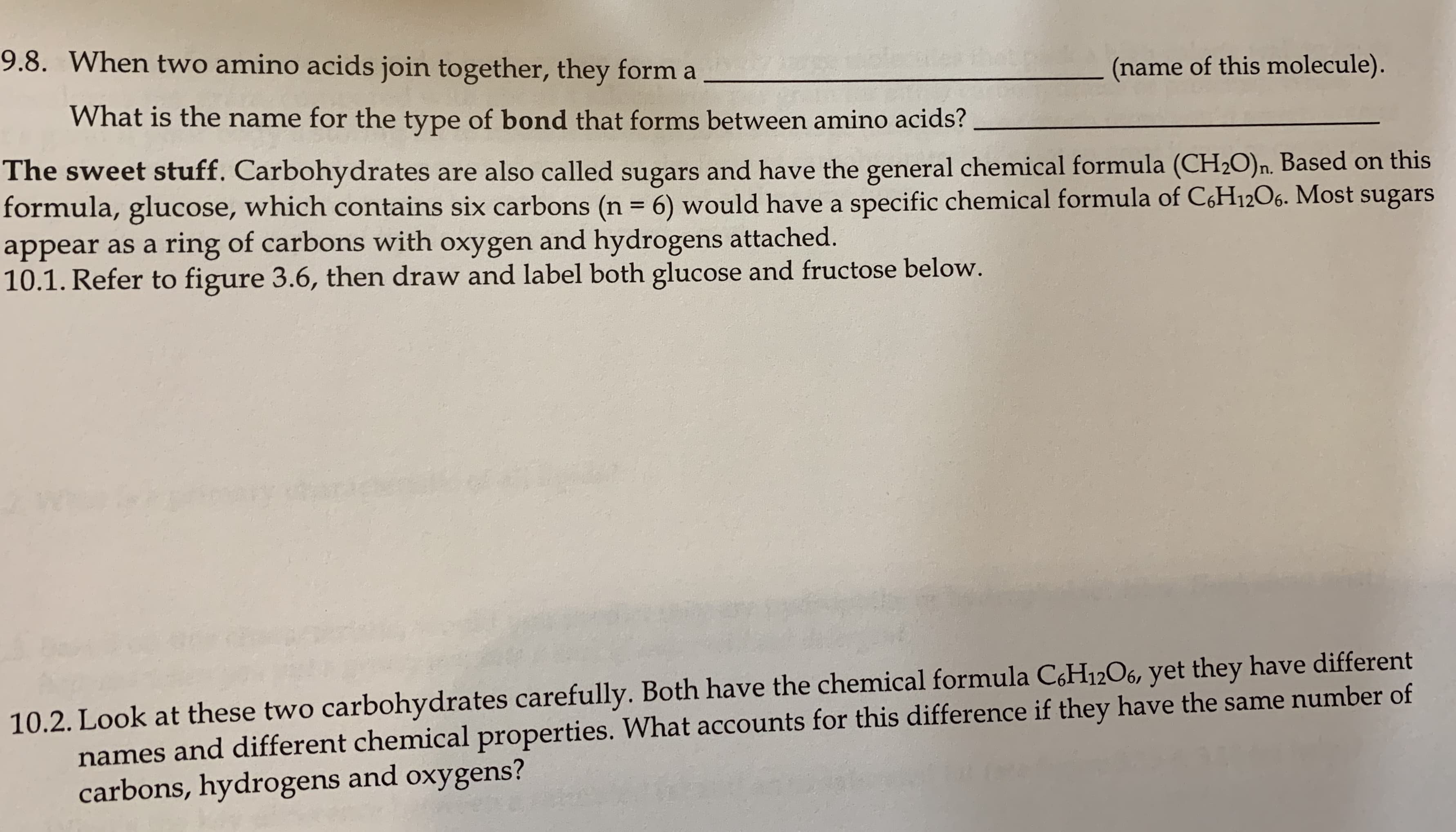9.8. When two amino acids join together, they form a (name of this molecule). What is the name for the type of bond that forms between amino acids? The sweet stuff. Carbohydrates are also called sugars and have the general chemical formula (CH2O)n. Based on this formula, glucose, which contains six carbons (n = 6) would have a specific chemical formula of C,H12O6. Most sugars appear as a ring of carbons with oxygen and hydrogens attached. 10.1. Refer to figure 3.6, then draw and label both glucose and fructose below. %3D 10.2. Look at these two carbohydrates carefully. Both have the chemical formula C,H12O6, yet they have different names and different chemical properties. What accounts for this difference if they have the same number of carbons, hydrogens and oxygens?
9.8. When two amino acids join together, they form a (name of this molecule). What is the name for the type of bond that forms between amino acids? The sweet stuff. Carbohydrates are also called sugars and have the general chemical formula (CH2O)n. Based on this formula, glucose, which contains six carbons (n = 6) would have a specific chemical formula of C,H12O6. Most sugars appear as a ring of carbons with oxygen and hydrogens attached. 10.1. Refer to figure 3.6, then draw and label both glucose and fructose below. %3D 10.2. Look at these two carbohydrates carefully. Both have the chemical formula C,H12O6, yet they have different names and different chemical properties. What accounts for this difference if they have the same number of carbons, hydrogens and oxygens?
General Chemistry - Standalone book (MindTap Course List)
11th Edition
ISBN:9781305580343
Author:Steven D. Gammon, Ebbing, Darrell Ebbing, Steven D., Darrell; Gammon, Darrell Ebbing; Steven D. Gammon, Darrell D.; Gammon, Ebbing; Steven D. Gammon; Darrell
Publisher:Steven D. Gammon, Ebbing, Darrell Ebbing, Steven D., Darrell; Gammon, Darrell Ebbing; Steven D. Gammon, Darrell D.; Gammon, Ebbing; Steven D. Gammon; Darrell
Chapter10: Molecular Geometry And Chemical Bonding Theory
Section: Chapter Questions
Problem 10.21QP: Best Lewis Formula and Molecular Geometry A student writes the Lewis electron-dot formula for the...
Related questions
Question

Transcribed Image Text:9.8. When two amino acids join together, they form a
(name of this molecule).
What is the name for the type of bond that forms between amino acids?
The sweet stuff. Carbohydrates are also called sugars and have the general chemical formula (CH2O)n. Based on this
formula, glucose, which contains six carbons (n = 6) would have a specific chemical formula of C,H12O6. Most sugars
appear as a ring of carbons with oxygen and hydrogens attached.
10.1. Refer to figure 3.6, then draw and label both glucose and fructose below.
%3D
10.2. Look at these two carbohydrates carefully. Both have the chemical formula C,H12O6, yet they have different
names and different chemical properties. What accounts for this difference if they have the same number of
carbons, hydrogens and oxygens?
Expert Solution
This question has been solved!
Explore an expertly crafted, step-by-step solution for a thorough understanding of key concepts.
This is a popular solution!
Trending now
This is a popular solution!
Step by step
Solved in 2 steps with 2 images

Recommended textbooks for you

General Chemistry - Standalone book (MindTap Cour…
Chemistry
ISBN:
9781305580343
Author:
Steven D. Gammon, Ebbing, Darrell Ebbing, Steven D., Darrell; Gammon, Darrell Ebbing; Steven D. Gammon, Darrell D.; Gammon, Ebbing; Steven D. Gammon; Darrell
Publisher:
Cengage Learning

Organic Chemistry: A Guided Inquiry
Chemistry
ISBN:
9780618974122
Author:
Andrei Straumanis
Publisher:
Cengage Learning

Chemistry: The Molecular Science
Chemistry
ISBN:
9781285199047
Author:
John W. Moore, Conrad L. Stanitski
Publisher:
Cengage Learning

General Chemistry - Standalone book (MindTap Cour…
Chemistry
ISBN:
9781305580343
Author:
Steven D. Gammon, Ebbing, Darrell Ebbing, Steven D., Darrell; Gammon, Darrell Ebbing; Steven D. Gammon, Darrell D.; Gammon, Ebbing; Steven D. Gammon; Darrell
Publisher:
Cengage Learning

Organic Chemistry: A Guided Inquiry
Chemistry
ISBN:
9780618974122
Author:
Andrei Straumanis
Publisher:
Cengage Learning

Chemistry: The Molecular Science
Chemistry
ISBN:
9781285199047
Author:
John W. Moore, Conrad L. Stanitski
Publisher:
Cengage Learning

Chemistry & Chemical Reactivity
Chemistry
ISBN:
9781337399074
Author:
John C. Kotz, Paul M. Treichel, John Townsend, David Treichel
Publisher:
Cengage Learning

Chemistry & Chemical Reactivity
Chemistry
ISBN:
9781133949640
Author:
John C. Kotz, Paul M. Treichel, John Townsend, David Treichel
Publisher:
Cengage Learning

Introductory Chemistry: A Foundation
Chemistry
ISBN:
9781337399425
Author:
Steven S. Zumdahl, Donald J. DeCoste
Publisher:
Cengage Learning